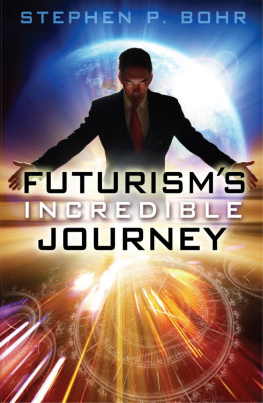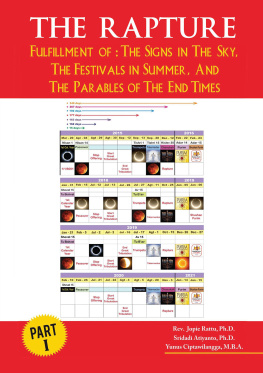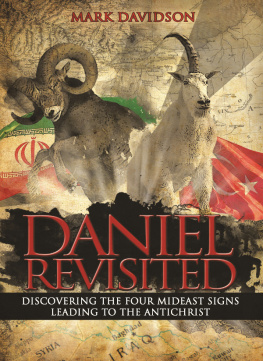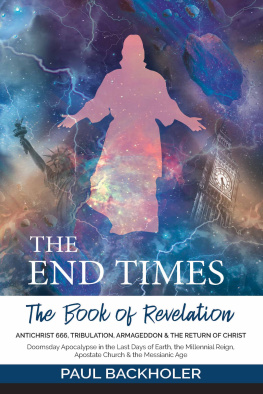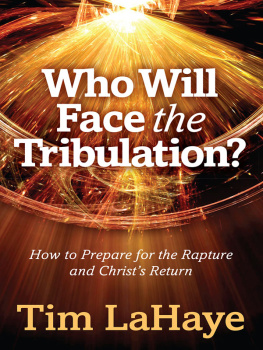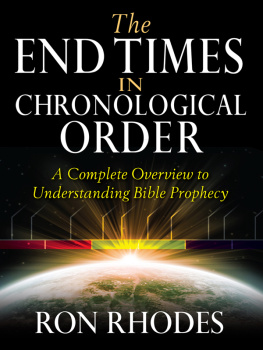
The Change of the Times and its
Implications for Seventh-day
Adventist Apocalyptic Interpretation


Roseville, CA
Copyright 2009 by Stephen P. Bohr
All rights reserved.
Printed in the USA
Published by
Amazing Facts, Inc.
PO Box 1058
Roseville, CA 95678-8058
1-800-538-7275
Scripture taken from the New King James Version.
Copyright 1982 by Thomas Nelson, Inc.
Used by permission. All rights reserved.
Cover Design by Haley Trimmer
Text Layout by Greg Solie AltamontGraphics.com
ISBN 978-1-58019-295-8
Contents
Appendix:
Foreword
B y means of a secret rapture, millions of Christians will suddenly vanish. Snatched up to heaven to meet Christ in the clouds, they will not have to face the trials that are to come upon the earth. This disappearing act ushers in the seven-year tribulation. For the first three-and-one-half years human conditions gradually deteriorate. Meanwhile, political and military power shifts to a European confederacy led by the Antichrist. This strong man miraculously survives a head wound and gains unprecedented power. At a point of crisis he orchestrates a seven-year peace treaty in the Middle East. However, the Antichrist, who bears Satans mark666then demonstrates his true nature. About midway through the tribulation he and his assistant, the false prophet, terrorize the world and compel everyone to bear the mark 666 on their hands or forehead.
At this point the Antichrist moves to Jerusalem from Rome, where he has been ruling. In the rebuilt temple of Jerusalem he blasphemes God, breaks the peace pact, and persecutes Israel. All chaos breaks outlooting, arson, famines, pollution, plagues, drug abuse, occultism, demon possession, economic dislocations, and lawlessness are rampant. Natural disasters abound: earthquakes destroy the land, the weather becomes bizarre, and stars fall from the sky.
Then, as history draws to a close, a great battle takes place. Armies from the North, the Far East, and Arab nations meet on the mountain of Megiddo in Israel. The bloody battle of Armageddon rages for about a year, killing millions of people. Jesus Christ now appears, destroying what is left of the armies and throwing the Antichrist and the false prophet into the lake of fire. The long-awaited millenniumthe thousand-year utopianow begins. From Jerusalem, Jesus and His saints will rule the world.
But this is not the end. After the thousand years of peace, Satan is released from the bottomless pit. Organizing an army for the final battle, he challenges God for one last time. Fire comes down from heaven, destroying these satanic forces, and the devil is cast into the lake of fire. The dead are now resurrected for the last judgment. The individuals whose names are not found in the book of life are cast into hell forever. God now creates a new heaven and a new earth. Peace and joy will now reign forever.1
This scenario, as described by Richard Kyle, does not come from some fictional novel. It is the fundamental prophetic belief system of millions of Christians who claim to believe in Bible inerrancy. Though it appears bizarre, it is proclaimed as gospel truth by thousands of Protestant ministers and Bible teachers around the world.
Where does this sensational prophetic scenario come from? Is it firmly based on the testimony of the holy Scriptures? Has it always been believed by the Christian church? Is this really what the final conflict will look like or is Protestantism setting itself up for an overmastering delusion?
Keep readingbecause what you dont know can hurt you!
Chapter 1
Changing of the Times
D aniel 7 contains one of the most remarkable prophecies in the Bible.2 It gives a one hundred percent accurate and trustworthy portrayal of the history of the world from the days of Daniel till the end of time. This history, however, is not given in straightforward language but rather in symbols that must be decoded.
Virtually all conservative students of Bible prophecy agree that the four beasts in this chapter represent four successive world empires beginning with Babylon and continuing with the Medes and Persians, Greece, and Rome. But here the agreement ends. Whereas historicist expositors have taught that the chapter presents a continuous flow of historical events without any gaps or interruptions, futurist expositors see a gap of more than fifteen centuries between the period of the dragon and the period of the ten horns and the little horn.
The following chart will illustrate the difference between the two schools:
Historicist Perspective | Futurist Perspective |
Lion = Babylon = 605539 b.c. | Lion = Babylon = 605539 b.c. |
Bear = Medes and Persians = 539331 b.c. | Bear = Medes & Persians = 539331 b.c. |
Leopard = Greece = 331168 b.c. | Leopard = Greece = 331168 b.c. |
Dragon = Rome = 168 B.C.476 a.d. | Dragon = Rome = 168 b.c.476 a.d. |
Ten horns = Divided Rome = 476538 a.d. | GAP OF OVER 1500 years |
Little horn = Papal Rome = 5381798 a.d. | Ten horns (ten-nation federation, not yet fulfilled) |
Little horn (Antichrist, not yet fulfilled) |
As can be seen in the chart, historicists have interpreted the ten horns as a symbolic portrayal of the fragmentation of the ancient Roman Empire into ten kingdoms in consequence of the barbarian invasions. They have also interpreted the little horn as the Roman Catholic papacy that arose after and in the midst of those ten kingdoms.
Futurists generally agree with historicists that the dragon beast represents the ancient Roman Empire that passed away in the fifth century. But contrary to historicists, futurists believe that the Roman Empire will be revived at the time of the rapture and that a ten-nation federation will rise from it to be followed shortly thereafter by the Antichrist. Thus futurists see a gap of over fifteen hundred years between the rule of the fourth beast and the rule of the ten horns and the little horn. It is obvious that in the futurist scenario, the long career of the Roman Catholic papacy has nothing to do with the fulfillment of the prophecy of Daniel 7.
Changing Times and the Law
The central verse that will concern us in this study is Daniel 7:25 where the work of the little horn (the Antichrist) is described: He [the little horn] shall speak pompous words against the Most High, shall persecute the saints of the Most High, And shall intend to change times [Aramaic: zeman ] and law: Then the saints shall be given into his hand For a time [Aramaic: iddan ] and times [ iddan ] and half a time [ iddan ]3 (Emphasis supplied).
The central thesis of this book is that Daniel 7:25 contains a prediction, given over 2500 years ago, of the rise of the particular futuristic hermeneutic4 with which we began this book and which is illustrated in the chart above. Our study will focus particularly on two malefic acts of the little horn, namely the change in the times and in the law.
Seventh-day Adventists have dedicated a great deal of space to the little horns attempted change in the law but the same amount of space has not been dedicated to explain what is meant by the attempted change in the times. Those Seventh-day Adventists who have taken the time to discuss the change in the times have generally concluded that Daniel 7:25 is simply referring to a change of the times in the law, and of course, the only commandment in the law that has to do with time is the Sabbath, thus the change in the Sabbath.5
Next page
